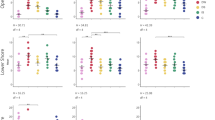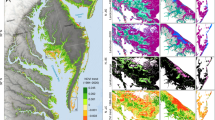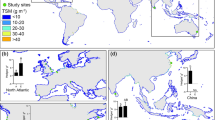Abstract
Coastal wetlands, existing at the interface between land and sea, are highly vulnerable to climate change1,2,3. Macroclimate (for example, temperature and precipitation regimes) greatly influences coastal wetland ecosystem structure and function4,5. However, research on climate change impacts in coastal wetlands has concentrated primarily on sea-level rise and largely ignored macroclimatic drivers, despite their power to transform plant community structure6,7,8,9,10,11,12 and modify ecosystem goods and services5,13. Here, we model wetland plant community structure based on macroclimate using field data collected across broad temperature and precipitation gradients along the northern Gulf of Mexico coast. Our analyses quantify strongly nonlinear temperature thresholds regulating the potential for marsh-to-mangrove conversion. We also identify precipitation thresholds for dominance by various functional groups, including succulent plants and unvegetated mudflats. Macroclimate-driven shifts in foundation plant species abundance will have large effects on certain ecosystem goods and services5,14,15,16. Based on current and projected climatic conditions, we project that transformative ecological changes are probable throughout the region this century, even under conservative climate scenarios. Coastal wetland ecosystems are functionally similar worldwide, so changes in this region are indicative of potential future changes in climatically similar regions globally.
This is a preview of subscription content, access via your institution
Access options
Access Nature and 54 other Nature Portfolio journals
Get Nature+, our best-value online-access subscription
$29.99 / 30 days
cancel any time
Subscribe to this journal
Receive 12 print issues and online access
$209.00 per year
only $17.42 per issue
Buy this article
- Purchase on Springer Link
- Instant access to full article PDF
Prices may be subject to local taxes which are calculated during checkout





Similar content being viewed by others
Change history
06 February 2017
In the original version of this Letter in the legend of Figure 2, 'algal mats' was misspelt. This error has been corrected in the online versions.
References
Gedan, K. B., Silliman, B. R. & Bertness, M. D. Centuries of human-driven change in salt marsh ecosystems. Annu. Rev. Mar. Sci. 1, 117–141 (2009).
McKee, K., Rogers, K. & Saintilan, N. in Global Change and the Function and Distribution of Wetlands: Global Change Ecology and Wetlands (ed. Middleton, B. A.) 63–96 (Springer, 2012).
Morris, J. T., Sundareshwar, P. V., Nietch, C. T., Kjerfve, B. & Cahoon, D. R. Responses of coastal wetlands to rising sea level. Ecology 83, 2869–2877 (2002).
Whittaker, R. H. Communities and Ecosystems (Macmillan, 1975).
Osland, M. J. et al. Beyond just sea-level rise: considering macroclimatic drivers within coastal wetland vulnerability assessments to climate change. Glob. Change Biol. 22, 1–11 (2016).
Osland, M. J., Enwright, N., Day, R. H. & Doyle, T. W. Winter climate change and coastal wetland foundation species: salt marshes vs. mangrove forests in the southeastern United States. Glob. Change Biol. 19, 1482–1494 (2013).
Cavanaugh, K. C. et al. Poleward expansion of mangroves is a threshold response to decreased frequency of extreme cold events. Proc. Natl Acad. Sci. USA 111, 723–727 (2014).
Cavanaugh, K. C. et al. Integrating physiological threshold experiments with climate modeling to project mangrove species’ range expansion. Glob. Change Biol. 21, 1928–1938 (2015).
Saintilan, N., Wilson, N. C., Rogers, K., Rajkaran, A. & Krauss, K. W. Mangrove expansion and salt marsh decline at mangrove poleward limits. Glob. Change Biol. 20, 147–157 (2014).
Alongi, D. M. The impact of climate change on mangrove forests. Curr. Clim. Change Rep. 1, 30–39 (2015).
Montagna, P., Gibeaut, J. & Tunnell, J. W. J. in The Changing Climate of South Texas 1900–2100: Problems and Prospects, Impacts and Implications—CREST-RESSACA (eds Norwine, J. & Kuruvilla, J.) 57–77 (Texas A&M Univ., 2007).
Osland, M. J., Enwright, N. & Stagg, C. L. Freshwater availability and coastal wetland foundation species: ecological transitions along a rainfall gradient. Ecology 95, 2789–2802 (2014).
Ellison, A. M. et al. Loss of foundation species: consequences for the structure and dynamics of forested ecosystems. Front. Ecol. Environ. 3, 479–486 (2005).
Bianchi, T. S. et al. Historical reconstruction of mangrove expansion in the Gulf of Mexico: linking climate change with carbon sequestration in coastal wetlands. Estuar. Coast. Shelf Sci. 119, 7–16 (2013).
Doughty, C. L. et al. Mangrove range expansion rapidly increases coastal wetland carbon storage. Estuar. Coast. 39, 385–396 (2016).
Yando, E. S. et al. Salt marsh-mangrove ecotones: using structural gradients to investigate the effects of woody plant encroachment on plant-soil interactions and ecosystem carbon pools. J. Ecol. 104, 1020–1031 (2016).
Millennium Ecosystem Assessment Ecosystems and Human Well-Being—Synthesis Report (World Resources Institute, 2005).
Barbier, E. B. et al. The value of estuarine and coastal ecosystem services. Ecol. Monogr. 81, 169–193 (2011).
De Groot, R. et al. Global estimates of the value of ecosystems and their services in monetary units. Ecosys. Serv. 1, 50–61 (2012).
Glick, P., Stein, B. & Edelson, N. Scanning the Conservation Horizon: A Guide to Climate Change Vulnerability Assessment (National Wildlife Federation, 2011).
Twilley, R. R. & Day, J. W. in Estuarine Ecology (eds Day, J. W., Crump, B. C., Kemp, M. W. & Yanez-Arancibia, A.) 165–202 (Wiley, 2012).
Pennings, S. C., Siska, E. L. & Bertness, M. D. Latitudinal differences in plant palatability in Atlantic coast salt marshes. Ecology 82, 1344–1359 (2001).
Zedler, J. The Ecology of Southern California Coastal Salt Marshes: A Community Profile FWS/OBS-81/54 (US Fish and Wildlife Service, 1982).
Guo, H. Y., Zhang, Y. H., Lan, Z. J. & Pennings, S. C. Biotic interactions mediate the expansion of black mangrove (Avicennia germinans) into salt marshes under climate change. Glob. Change Biol. 19, 2765–2774 (2013).
Armitage, A. R., Highfield, W. E., Brody, S. D. & Louchouarn, P. The contribution of mangrove expansion to salt marsh loss on the Texas Gulf Coast. PLoS ONE 10, e0125404 (2015).
Osland, M. J. et al. Mangrove expansion and contraction at a poleward range limit: climate extremes and land-ocean temperature gradients. Ecology 98, 125–137 (2017).
Eslami-Andargoli, L., Dale, P., Sipe, N. & Chaseling, J. Mangrove expansion and rainfall patterns in Moreton Bay, southeast Queensland, Australia. Estuar. Coast. Shelf Sci. 85, 292–298 (2009).
Kirwan, M. L. & Megonigal, J. P. Tidal wetland stability in the face of human impacts and sea-level rise. Nature 504, 53–60 (2013).
Krauss, K. W. et al. How mangrove forests adjust to rising sea level. New Phytol. 202, 19–34 (2014).
Kirwan, M. L., Temmerman, S., Skeehan, E. E., Guntenspergen, G. R. & Fagherazzi, S. Overestimation of marsh vulnerability to sea level rise. Nat. Clim. Change 6, 253–260 (2016).
VDatum Version 3.4 (NOAA, 2015); http://vdatum.noaa.gov
Daly, C. et al. Physiographically sensitive mapping of climatological temperature and precipitation across the conterminous United States. Int. J. Climatol. 28, 2031–2064 (2008).
PRISM Climate Group, Oregon State Univ. (2015); http://prism.oregonstate.edu
Frazier, A. E. & Wang, L. Modeling landscape structure response across a gradient of land cover intensity. Landsc. Ecol. 28, 233–246 (2013).
Hufkens, K., Ceulemans, R. & Scheunders, P. Estimating the ecotone width in patchy ecotones using a sigmoid wave approach. Ecol. Inform. 3, 97–104 (2008).
Tomlinson, P. B. The Botany of Mangroves (Cambridge Univ. Press, 1986).
Flowers, T. J., Troke, P. F. & Yeo, A. R. The mechanism of salt tolerance in halophytes. Annu. Rev. Plant Physiol. 28, 89–121 (1977).
Khan, M. A., Ungar, I. A. & Showalter, A. M. The effect of salinity on the growth, water status, and ion content of a leaf succulent perennial halophyte, Suaeda fruticosa (L.) Forssk. J. Arid. Environ. 45, 73–84 (2000).
Lot-Helgueras, A., Vázquez-Yanes, C. & Menendez, F. in Proceedings of the International Symposium on Biology and Management of Mangroves (eds Walsh, G. E., Snedaker, S. C. & Teas, H. J.) 52–64 (Institute of Food and Agricultural Sciences, Univ. Florida, 1975).
Méndez-Alonzo, R., López-Portillo, J. & Rivera-Monroy, V. H. Latitudinal variation in leaf and tree traits of the mangrove Avicennia germinans (Avicenniaceae) in the central region of the Gulf of Mexico. Biotropica 40, 449–456 (2008).
Lugo, A. E. & Patterson-Zucca, C. The impact of low temperature stress on mangrove structure and growth. Trop. Ecol. 18, 149–161 (1977).
Madrid, E. N., Armitage, A. R. & López-Portillo, J. Avicennia germinans (black mangrove) vessel architecture is linked to chilling and salinity tolerance in the Gulf of Mexico. Front. Plant Sci. 5, 00503 (2014).
National Wetlands Inventory (US Fish and Wildlife Service, 2015); http://www.fws.gov/wetlands
IPCC Climate Change 2013: The Physical Science Basis (Cambridge Univ. Press, 2013).
Abatzoglou, J. T. Development of gridded surface meteorological data for ecological applications and modelling. Int. J. Climatol. 33, 121–131 (2013).
Livneh, B. et al. A long-term hydrologically based dataset of land surface fluxes and states for the conterminous United States: update and extensions. J. Clim. 26, 9384–9392 (2013).
Acknowledgements
We are grateful for the support of the US Department of the Interior South Central Climate Science Center, US Geological Survey’s Ecosystems Mission Area, US Geological Survey’s Climate and Land Use Change R&D Program, Gulf Coastal Plains and Ozarks Landscape Conservation Cooperative, and the University of Houston. For facilitating our field collections, we thank Padre Island National Seashore, Texas Parks and Wildlife Department, King Ranch, Coastal Bend Bays and Estuaries Program, Hillsborough County, Manatee County, multiple US Fish and Wildlife Service National Wildlife Refuges, and multiple National Estuarine Research Reserves. C.A.G. thanks J. Gabler for numerical modelling assistance. We thank K. Krauss for a thoughtful manuscript review. Any use of trade, firm, or product names is for descriptive purposes only and does not imply endorsement by the US Government.
Author information
Authors and Affiliations
Contributions
All authors helped design the project and data collection protocols. C.A.G., M.J.O., A.S.F., M.L.M., J.L.M., N.M.E., R.H.D. and S.B.H. collected the data. C.A.G. analysed the data and created the figures. C.A.G. and M.J.O. wrote the first manuscript draft, and all authors contributed to revisions.
Corresponding author
Ethics declarations
Competing interests
The authors declare no competing financial interests.
Supplementary information
Supplementary Information
Supplementary Information (PDF 7047 kb)
Rights and permissions
About this article
Cite this article
Gabler, C., Osland, M., Grace, J. et al. Macroclimatic change expected to transform coastal wetland ecosystems this century. Nature Clim Change 7, 142–147 (2017). https://doi.org/10.1038/nclimate3203
Received:
Accepted:
Published:
Issue Date:
DOI: https://doi.org/10.1038/nclimate3203
This article is cited by
-
Rapid greening in mangroves
Nature Ecology & Evolution (2024)
-
Shrub Age and Water Dynamics Influence Primary Production, Carbon, and Nitrogen Stocks in a Coastal Environment
Wetlands (2024)
-
Transformative Impacts of Sea-Level Rise, Storm Surge, and Wetland Migration on Intertidal Native Shell-Bearing Sites in Florida’s Largest Open-Water Estuary, Tampa Bay, Florida, USA
Estuaries and Coasts (2024)
-
Reproductive Responses to Increased Shoot Density and Global Change Drivers in a Widespread Clonal Wetland Species, Schoenoplectus americanus
Estuaries and Coasts (2024)
-
Temperature Thresholds for Leaf Damage from Two Extreme Freeze Events (2018 and 2021) Near the Northern Range Limit of Black Mangroves (Avicennia germinans) in Southeastern North America
Estuaries and Coasts (2024)



